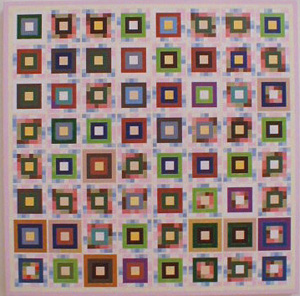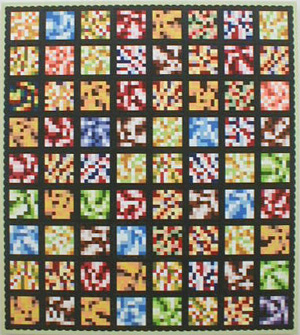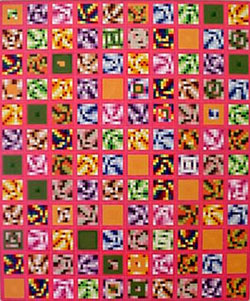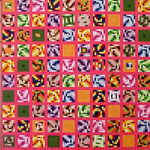For pristine grid paintings, they’re quite yucky. Melissa Thorne takes three afghans and a quilt and renders them in immaculately smooth acrylic paint on canvas, making a straightforward translation of a low-craft object into high art. The incredibly even, semi-matte surfaces give the paintings a high-tech slickness, while Thorne’s watery, semi-transparent colors downplay the inevitable reference to digital imagery, creating an intriguing tension that’s neither funky nor futuristic.
It’s all about finish: a fetishized love of surface and the repetitive labor which produces it. Thorne painstakingly re-creates afghan patterns in paint, sanding and re-sanding layers of gesso under her acrylic paint until the paintings a fair imitation of her translucent ink-on-mylar drawings. Like afghans, Thorne’s paintings are a compilation of minute efforts. It’s the one-to-one correspondence between stitches and tiny painted squares — the careful process — that puts Thorne’s work in sympathy with the craft objects she re-creates and makes the paintings more than a glib high art/low craft joke.

The one quilt-based painting in the show:...Melissa Thorne, Untitled, 2002...acrylic on canvas, 37.75
They’re slow paintings, and they stubbornly refuse to be pigeonholed. Though sunny and delicate, they’re too energetic to be exercises in new-age spirituality. They can be seen as aggressively feminist, pointing out the unsung creativity of a mostly female crafting population relegated to second class status in a male-centric artworld, but that’s a side issue. Like all pattern paintings, they’re implicitly subversive in their gentle assertion that a painting is just pretty colors on canvas — but they’re not all that pretty. they’re campy pictures of afghans, down to the silly scalloped edging, but straightlaced technique keeps them from wallowing in kitsch for it’s own sake. Afghans, feminism, kitsch, abstraction, color, etc. are all secondary to Thorne’s technical process.
I think of the four untitled works in Thorne’s show as the Traditional Afghan (with scalloped edging), the Little Pink Quilt, the Awful Mishmash, and the Melon. The Traditional Afghan is funniest. It spreads one of the most common afghan patterns across the canvas like a trophy zebra pelt, making the craft/art point with deadpan seriousness. The Quilt is prettiest. As I said, it makes the most satisfying painting, if not the most thought-provoking one. The Awful Mishmash is butt-ugly, a jarring juxtaposition of soft, variegated squares and hard, graphic blocks of apple green and fluorescent hot pink, separated by a spindly black grid. It’s gross, but I like that. The Melon is gross, too, but less aggressively so. It’s fleshy, pinkish grid-lines enforce a sort of harmony across the dissonant but relatively weak squares.
I think of the four untitled works in Thorne’s show as the Traditional Afghan (with scalloped edging), the Little Pink Quilt, the Awful Mishmash, and the Melon. The Traditional Afghan is funniest. It spreads one of the most common afghan patterns across the canvas like a trophy zebra pelt, making the craft/art point with deadpan seriousness. The Quilt is prettiest. As I said, it makes the most satisfying painting, if not the most thought-provoking one. The Awful Mishmash is butt-ugly, a jarring juxtaposition of soft, variegated squares and hard, graphic blocks of apple green and fluorescent hot pink, separated by a spindly black grid. It’s gross, but I like that. The Melon is gross, too, but less aggressively so. It’s fleshy, pinkish grid-lines enforce a sort of harmony across the dissonant but relatively weak squares.
At quilt conventions, the quilts are typically hung on the wall, simulating paintings. It’s interesting that the one quilt-based piece in the show (pink), with the graphic crispness and appealing color interplay of an Albers, reads much more like a painting than the afghan-based pieces with their muzzy, dissonant variegations. Thorne takes advantage of this awkwardness to breathe new, if queasy, life into the tired grid-painting genre.
Images are courtesy the artist and Devin Borden Hiram Butler Gallery.
Bill Davenport is an artist and writer and was one of the first contributors to Glasstire.






